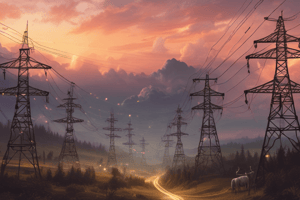Podcast
Questions and Answers
What is the primary purpose of high-voltage transmission in power systems?
What is the primary purpose of high-voltage transmission in power systems?
- To distribute power to end-users at lower voltages
- To deliver power to individual consumers with high reliability and safety
- To transport bulk power over long distances with minimal loss of energy (correct)
- To monitor and control the power grid in real-time
What is the typical voltage range for electric power distribution?
What is the typical voltage range for electric power distribution?
- Between 100 kV and 765 kV
- Above 100 kV
- Below 100 kV (correct)
- Above 765 kV
What is the primary function of transformers in power transmission?
What is the primary function of transformers in power transmission?
- To monitor power flow in real-time
- To step down voltage for distribution
- To step up voltage for transmission (correct)
- To isolate faults in the power grid
What is the key characteristic of transmission lines?
What is the key characteristic of transmission lines?
What is the primary purpose of distribution networks?
What is the primary purpose of distribution networks?
What is the key technology used in grid management for real-time monitoring and control?
What is the key technology used in grid management for real-time monitoring and control?
What is the primary function of switchgear and circuit breakers in power transmission?
What is the primary function of switchgear and circuit breakers in power transmission?
What is the key aspect of grid management for ensuring reliability and efficiency?
What is the key aspect of grid management for ensuring reliability and efficiency?
Flashcards are hidden until you start studying
Study Notes
Power Transmission
- High-voltage transmission of electrical energy from power plants to substations near load centers
- Typically operates at voltages above 100 kV
- Purpose: to transport bulk power over long distances with minimal loss of energy
- Key components:
- Transmission lines (overhead or underground)
- Transformers (step-up and step-down)
- Switchgear and circuit breakers
Electric Power Distribution
- Lower-voltage distribution of electrical energy from substations to end-users (homes, businesses, etc.)
- Typically operates at voltages below 100 kV
- Purpose: to deliver power to individual consumers with high reliability and safety
- Key components:
- Distribution lines (overhead or underground)
- Transformers (step-down)
- Distribution panels and switchgear
Transmission Lines
- High-voltage conductors used to transmit power over long distances
- Types:
- Overhead transmission lines (towers and conductors)
- Underground transmission lines (cables)
- Characteristics:
- High voltage (up to 765 kV)
- High current capacity
- Designed to minimize energy loss and ensure reliability
Distribution Networks
- Network of power lines, transformers, and equipment that deliver electricity to end-users
- Characteristics:
- Radial or mesh topology
- Operates at lower voltages (up to 35 kV)
- Designed for reliability, safety, and efficiency
- Components:
- Distribution lines
- Distribution transformers
- Service drops (connections to individual consumers)
Grid Management
- Real-time monitoring and control of the power grid to ensure reliability, efficiency, and safety
- Key aspects:
- Load forecasting and demand response
- Transmission and distribution system monitoring
- Fault detection and isolation
- Power flow optimization and voltage control
- Technologies:
- Advanced sensors and IoT devices
- SCADA (Supervisory Control and Data Acquisition) systems
- Advanced data analytics and machine learning algorithms
Power Transmission
- High-voltage transmission of electrical energy operates at voltages above 100 kV
- Purpose is to transport bulk power over long distances with minimal loss of energy
- Key components include transmission lines, transformers, and switchgear and circuit breakers
Electric Power Distribution
- Lower-voltage distribution of electrical energy operates at voltages below 100 kV
- Purpose is to deliver power to individual consumers with high reliability and safety
- Key components include distribution lines, transformers, and distribution panels and switchgear
Transmission Lines
- High-voltage conductors used to transmit power over long distances have high voltage up to 765 kV
- High-voltage conductors also have high current capacity and are designed to minimize energy loss
- There are two types of transmission lines: overhead transmission lines and underground transmission lines
Distribution Networks
- Distribution networks have radial or mesh topology and operate at lower voltages up to 35 kV
- Key components of distribution networks include distribution lines, distribution transformers, and service drops
- Distribution networks are designed for reliability, safety, and efficiency
Grid Management
- Real-time monitoring and control of the power grid ensure reliability, efficiency, and safety
- Key aspects of grid management include load forecasting and demand response, transmission and distribution system monitoring, fault detection and isolation, and power flow optimization and voltage control
- Advanced technologies used in grid management include advanced sensors and IoT devices, SCADA systems, and advanced data analytics and machine learning algorithms
Studying That Suits You
Use AI to generate personalized quizzes and flashcards to suit your learning preferences.


